Obsessed: The World's Largest Cookbook Collection
A retired forensic anthropologist who, according to Guinness World Records, owns more cookbooks than anyone else.
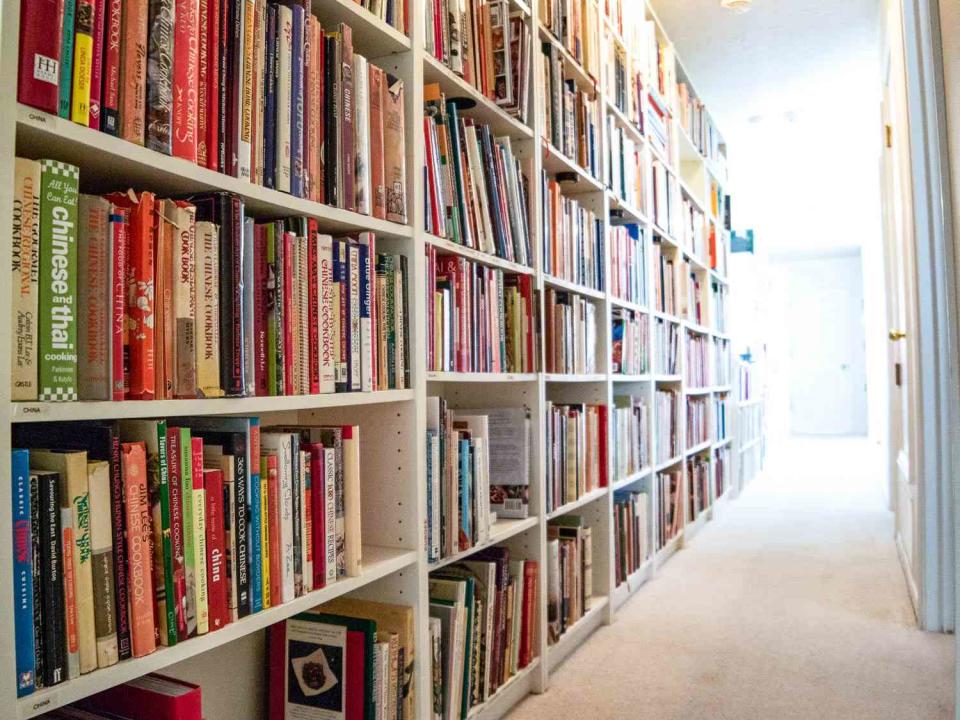
Serious Eats / Stephanie Cameron
I like to think there's a special place in the realm of obsessive behavior reserved for collections and their collectors—those men and women intent on the gathering up of objects according to some specific theme, like bottle caps, snow globes, or all things Elvis. As we thought about who else to add to our own little collection of culinary obsessives, it seemed only fitting to find a collector of some kind, and that's how we stumbled upon Sue Jimenez, a retired forensic anthropologist who, according to Guinness World Records, owns the largest cookbook collection in the entire world.
Sue's record dates back to 2013, at which time she had 2,970 cookbooks; five years later, she claims to own almost 7,000, all of which she keeps in her home. (She is quick to point out, however, that this is an "unofficial" tally, and will likely remain that way, as the process of having it verified is something of a hassle.) As a collection, hers isn’t like a book of stamps; that is, these cookbooks are meant to be used. For the most part, her books aren’t antiques, so, despite the fact that some of the pamphlets she owns are so old that the pages have become friable, they aren’t siloed away in clear plastic covers, forbidden to be read, like my cousin's old comic book collection. Aside from using the books as they were intended, Sue also periodically writes about them on her blog, The Vintage Cookbookery.
I spoke to Sue about how she got started with her collection, getting certified by Guinness World Records, and why she finds cookbooks so fascinating.
Name: Sue Jimenez
Age: "I was born in the same year that Winston Churchill became prime minister of the UK for the second time (you’ll have to figure this one out!)."
Day job: Retired forensic anthropologist
Facebook: Sue Jimenez
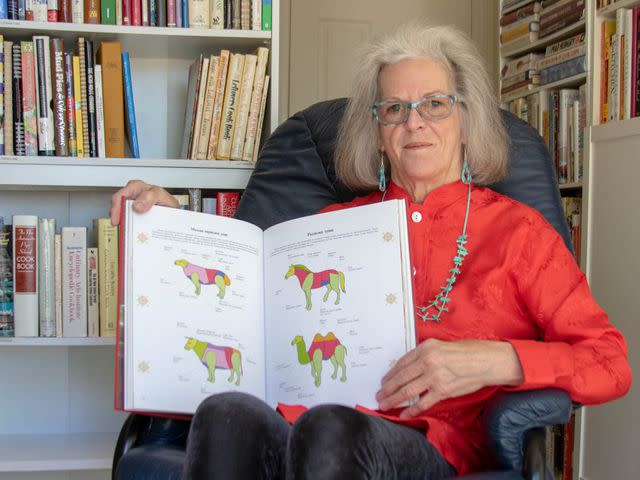
Serious Eats / Stephanie Cameron
Can you tell me a bit about yourself? From reading your blog, I gather that you’re originally from Canada. Is that right? What prompted you to move to the US/New Mexico?
Sue Jimenez: I have a split personality. I was born in the US, but my father was transferred to Toronto when I was three, to set up a manufacturing plant for his brother-in-law. It was intended to be temporary. After 17 years, he realized it was not a temporary job, so the whole family got Canadian citizenship. Thus, I have the best of both worlds (except at tax time).
The prompt to move from Canada to the US was a guy: my husband, Stan. He is also a retired forensic anthropologist, well known in our field and the author of several books on the subject. We met at the annual American Academy of Forensic Sciences meetings in Boston in 1993 and had an email relationship for several months. Well, one thing led to another, as it often does. I was teaching and working on my PhD in forensic anthropology at the University of Toronto, but still agreed to pull up roots after my teaching assignment ended in the spring of 1994, and moved to Albuquerque, where he was still a professor at the University of New Mexico. A very long story, but here I am, still.
When did you become interested in forensic anthropology?
SJ: It was a long, long time ago. In 1984, I was married, and my late husband passed away from cancer. It was a really brutal uphill battle for him, and after that I just felt so helpless, and I thought, “What am I going to do now?” I’d already been interested in anthropology, so after he passed away, I enrolled at the University of Toronto in a sort of Anthropology 101 class, and it was divided into two parts: social and cultural anthropology, and physical anthropology, which involves the study of human remains and skeletal biology. Boy, when I took the skeletal biology, I just thought, "This is for me." I was comfortable with it. I think because I felt so helpless...I felt like I could maybe speak for people who couldn't speak for themselves any longer. Does that make any sense?
I became a practicing forensic anthropologist in Canada, and when I moved to Albuquerque, I did contract work for the New Mexico Office of the Medical Investigator for a time. In 1996, I was contracted under the organization Physicians for Human Rights, which operated under the auspices of the United Nations and the International Criminal Tribunal for the former Yugoslavia, to work in Bosnia-Herzegovina for three months. My job was to analyze and try to determine the cause and manner of death, and identify the remains, of some of the hundreds of thousands of victims from the Bosnian wars in the early 1990s. I worked with a fabulous international team in all forensic disciplines, in a bombed-out garment factory. It was an eye-opening experience.
Following the demise of my PhD program (another long story), I spent 13 years working as a private investigator for a small firm in Albuquerque. I needed some income, and I loved research. I'm a born researcher. I investigated tort claims for the city and state, medical malpractice and wrongful-death cases, did background checks, locates, and the usual stuff.
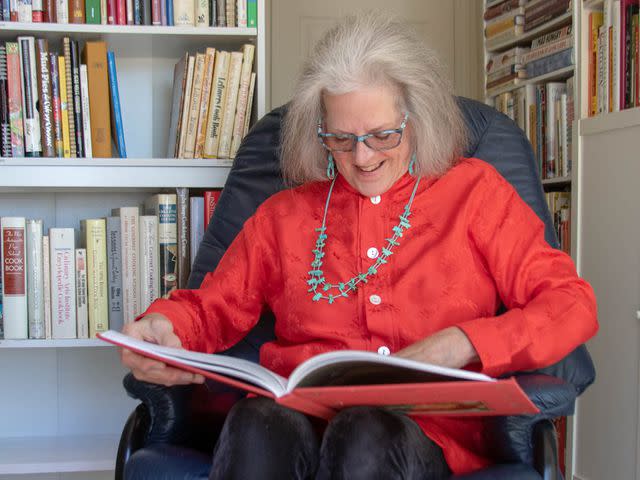
Serious Eats / Stephanie Cameron
What sparked your interest in cookbooks? How did you get started with your collection? What do you find so interesting about cookbooks?
SJ: Gee, I don’t know. When I was 18, my folks gave me the Time-Life Foods of the World series. The first thing I wanted to make was the six-foot-long cherry strudel from the German cookbook. I took over the kitchen, and I recall trying to stretch a small portion of dough on the counter and make it into a six-foot-by-four-foot rectangle. Somehow, with only a few tears, I succeeded, slathered canned cherry filling all over it, and cut it into manageable-size pieces to fit the oven. I suspect my folks wondered if they had opened Pandora’s box by giving me that set of cookbooks.
My current collection is not the first one. I always seem to have had a “bunch” of cookbooks, but I would guess that was only about 20 or 30. I think it was in 1997, after my forensic career kind of collapsed, when eBay was really just getting up and going, and I realized there were a lot of people looking for vintage cookbooks, which I'd always been interested in doing, but could never afford. I started buying antique and vintage cookbooks at estate sales, thrift stores, and used-book shops and selling them on eBay. I never made a dime—I was barely covering my expenses—but it was fun for a time. When I finally had to find gainful employment (the private-investigation job), I donated about 800 books I had amassed to the local “Friends of the Library.” A couple of months later, I read in the paper that they were having a special “cookbook” sale of used books. My spouse had to practically tie me down to calm my panic at seeing my beloved books going to other homes, and to stop me from rushing down to re-purchase them.
In 2005 I started slowly collecting again, in the same fashion. Almost all of them have come from, as I mentioned earlier, used-book stores, thrift shops, et cetera, and some from Edward Hamilton Bookshop, a wonderful remainder bookstore in Connecticut.
As the collection grew, it soon surpassed 1,000. On one occasion, when I received a box of books from Edward Hamilton, it put the total up to 1,020. Having passed a neat, round number, I felt obligated to continue to the next neat, round number of 2,000. I promised my husband I would stop then. Well, you can figure out the rest from there—2,000 became 3,000, and so on, and so on. In the fall of 2014, with the collection standing at about 4,500, I decided that something would have to go: either the cookbooks, or the small house we then lived in. The cookbooks won, and we moved from the northeast part of town to the southeast part, to a larger home. (It wasn’t so bad, as my husband got a much larger garage workspace, with a heater!)
The books are sort of the soul of the house, occupying two rooms and a 40-foot-long hall, which I have deemed “The Great Hall of Cookbooks.” (See my post on Wordpress, "How to Pack 1/2 an Elephant.") In my defense, my husband’s book collection (forensics, science, railroad history, et cetera) occupies one complete room as well. In addition, we have a bunch of “generic” books, so I would guess that, by now, we have about 9,000 books in our house, enough to start up a small-town library.
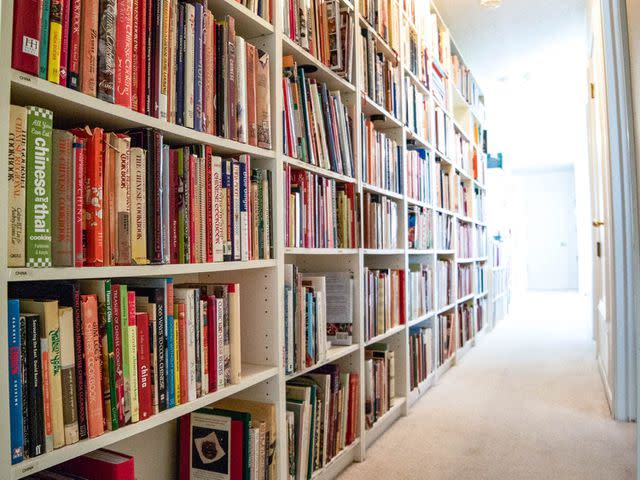
Serious Eats / Stephanie Cameron
How many cookbooks do you have now?
SJ: Well, the current total is 6,372. However, recall that the "official" Guinness total was 2,970, in July 2013, so the current total is "unofficial." However, it’s still a heck of a lot of cookbooks! I was featured a few times on local news channels and interviewed by the Albuquerque Journal some time ago. One of the local news channels introduced the short segment as "talk about weird collections," or something like that. Now, to me, someone who has a collection of 4,690 moist towelettes is weird; cookbooks, not so much. (Really, if you check The Guinness Book of World Records, you will find all kinds of collections.)
Do you cook from all these cookbooks, or do they satisfy a more academic interest? Do you think the collection has made you a better or more curious cook?
SJ: If you estimate that an average cookbook has about 100 recipes, I have about 630,000 recipes to choose from; however, many cookbooks have many more recipes, some fewer, so I guess that I have close to a million recipes to browse. Many of them that I use are not the usual ones a lot of collectors adore. Although I have many editions of Joy of Cooking, I seldom go to them, except to research things for my blog (see "A Vintage Cookbookery Mystery—The Curious Case of Irma Rombauer and the Missing Squirrel").
Until my spouse was diagnosed with congestive heart failure a little over a year ago, I used to experiment with 70 kinds of salt from around the world. I would go to the salt cupboard and randomly select a salt, from, say, Peru. Then, I’d go to my collection of Peruvian cookbooks and fashion a meal around the salt. I used to do the same with my pepper collection. Growing up, there was only Morton’s salt from the blue canister, and pepper that was already ground to a fine dust in a little jar. I had no idea there was so much diversity in food, herbs, and spices until I started really reading cookbooks.
I definitely think I have become a more curious cook and am willing to undertake just about anything, although I do have limits (I won’t kill or butcher an animal, ever!). I’ve traveled in countries where insects are the norm in food, and have even sampled a few, but I can’t get past the notion of bugs as food, somehow. For fun, I’ve tried a few experiments around food, using my very willing spouse as a guinea pig. So, I have a lot of fun with my cookbooks, and that includes cooking. I should also point out that I eschew fiction. It simply doesn’t interest me. I read cookbooks like other people read fiction (but I also get recipes from them!).
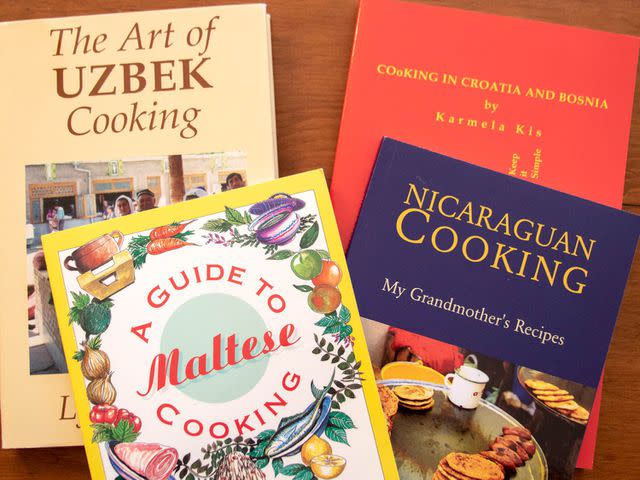
Serious Eats / Stephanie Cameron
Do you recall the first book you bought as a collector, as opposed to cookbooks you may have bought to use in the kitchen?
SJ: Wow, that’s a tough one, especially since this is my second collection, and between the one I donated and the current one, you’re talking about 8,000 books. I do recall, though, that it was probably one of the early pamphlets put out by the Jell-O people. I have about 150 small "cookbooklets" and such pamphlets, put out by food manufacturers, refrigerator and stove manufacturers, et cetera, and they are very colorful—the artist Max Parrish did a lot of the early artwork on Jell-O pamphlets. In addition, I recall finding a copy of the War-Time Cook and Health Book from 1917, published by the US government. Other early ones were Marvelous Meals With Minute Tapioca by Miss Dine-About-Town, published in 1938; Good Housekeeping’s Book of Menus, Recipes and Household Discoveries, published in 1920; and The Household Searchlight Recipe Book, which is from 1938. I still have all of these pamphlets.
I would have to say that I can’t really separate cookbooks as collector’s items from cookbooks I use in the kitchen. They are all fair game for recipes, as far as I’m concerned. You can flip through pages, you can dog-ear a page, you can put them down next to your bedside and read them later on. They're not antique-quality. They just have meaning to me as cookbooks and history, really. I also have approximately 200 books that are not cookbooks, per se, but are about food history, food trends and developments, and general research and facts about food and cooking, changes in agricultural practices and the future of food, et cetera.
Can you talk about some of your favorite books? What about them do you find compelling?
SJ: Another tough question. I would have to say my absolute favorite is a small book written by Marjorie Swift, and published in London in 1925, entitled Feed the Brute! It is a marvelous tongue-in-cheek book about the "brute...who, in most cases has to work very hard to provide for his family..." Marjorie goes on about the "brute": how to care for him, cook for him, remind him that he is charming, et cetera. She points out that "The well-fed man is a happy man—and a very easily 'managed' one, too. And since we women know that to maintain harmony every man, however clever, however efficient, however charming, must be 'managed,' let us feed him well first and manage him afterwards." There are no recipes, per se, in the book, but there are chapters on purchasing and cooking, and recommendations for both. Referring to the fish "whitebait," she notes that in the UK, "...the average cook’s idea of whitebait takes the form of a horrible mess of sticky little fishes united in death as most certainly they were not in life." A wonderful book!
Another favorite is one of my Canadian cookbooks, The Laura Secord Canadian Cook Book, which I’ve had for years. It has the dishes I grew up with in Toronto: butter tarts, maple sugar cookies, French-Canadian pea soup, glazed back bacon, and more.
The compelling part is twofold: the recipes and the history that each cookbook contains. Often, the history is more fascinating than the recipes.
When did you decide to start blogging about your books?
SJ: When I retired from my latest job in 2013, I knew I had to do something related to cooking and cookbooks, so thus my blog on Wordpress was founded. I never meant it to be a venue for recipes.... There are thousands of blogs out there for that. Rather, I was more interested in food and cultures, food in history, trends and fashions in food, food and wars, why we eat what we eat, et cetera. That's why there are very few recipes on the blog, and most of them have to do with the Southwest, like prickly pears I pick from my front yard and make jelly out of; publishing recipes from cookbooks is not really interesting to me.
Why do you include a song at the beginning of each entry? I don’t think that’s typical of food blogs.
SJ: Really? Gosh, that surprises me. Honestly, I don't follow other people's blogs. That sounds really tacky. Including music just seemed to me kind of a natural thing. You can find anything on the internet, and I can always find something to fit my posts. I never realized that a lot of people don't really do it or take advantage of the capability. I just think it's kind of a fun thing to do.
Can you talk about applying to Guinness World Records? What inspired you to do it? What was the process like? Have you thought about reapplying to update the record?
SJ: When I had purchased some new software to update my database of the collection, and realized that I had more than 2,500 cookbooks, I began looking at Guinness World Records for cookbooks. At the time, in 2012, the record had been held by Betsy Ross-McCoy since 2011. Ross-McCoy, who has been collecting since 1966, had amassed 1,225 cookbooks. I thought, "Hey, I got this."
Well, after months of emails back and forth between me and the Guinness people, and endless clarifications (which sometimes took months for a response), I had to cull out certain items in the collection: any cookbooks or cookbooklets or pamphlets issued by manufacturers (refrigerators, et cetera) were disqualified, as were multiple copies of books, unless they were different editions. Then I had to find two willing people, knowledgeable in the fields of books or cooking. That took some time. I finally found two willing participants: Chris Pope, executive chef of Zinc, a local Albuquerque restaurant, and Kirin Farrell, owner of Title Wave Books, agreed to do the counting. On the day of, coffee was supplied for the counters and TV crew, my boss at the time loaned me a surveillance camera to record the event (another prerequisite for Guinness), and afterwards, I fed the group dishes from 1920, 1930, 1940, and 1950. For example, I had one of these goofy Jell-O recipes from the 1950s, ones that probably your grandmother would've made and my mother would've made. They're totally tacky, with lime Jell-O and little bits of canned fruit embedded in them, but they're synonymous with the times.
I haven’t really considered reapplying to update the record, as it still stands, even though the collection has more than doubled since 2013. I don’t think I want to go through the year-long hassle again! There was an article about a year ago about a lady in Nevada who claims to have 10,000 cookbooks, but they appeared to be all stored in boxes in her house, and I don’t know how she could tell how many she has, or if they were catalogued. At any rate, apparently she didn’t challenge my record.
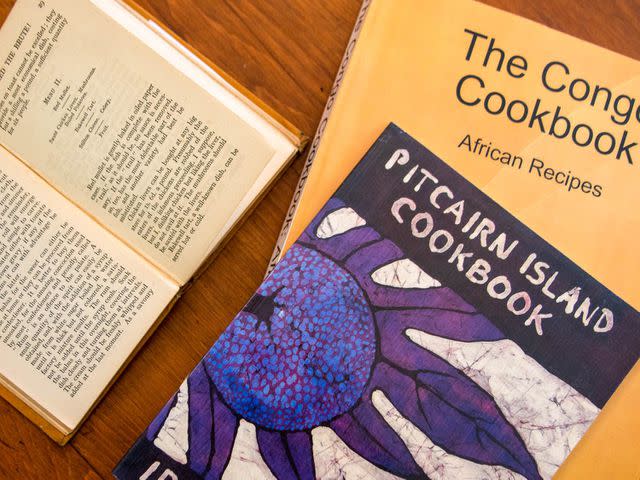
Serious Eats / Stephanie Cameron
How discriminating are you in adding to your collection? Will any cookbook do? How much time and effort do you put into expanding your collection?
SJ: Actually, I am fairly discriminating. I don’t buy cookbooks just for the sake of enlarging the collection. If that was the case, I’d have surpassed the 10,000 count long before now. My passion is collecting cookbooks that are older, out of print, unusual, quirky, international, or otherwise of more than a passing interest. I definitely don’t do diet cookbooks or "health" cookbooks, "paleo," "liquid diet," or similar books. They are just not my cup of tea. The only health-related cookbooks I currently have I purchased when my husband was placed on a very low-sodium diet, and I had to get more creative. I try to find books from outside of the US. The ingredients and recipes in them are far more intriguing to me, as they speak of cultures and the foods they have at their disposal. My goal is to obtain a cookbook from every country. At this time, I have cookbooks from about 115 countries, including the only cookbook ever published in the Pitcairn Islands, by a descendant of the 1789 Mutiny on the Bounty mutineers and their Tahitian wives; specifically Fletcher Christian.
Time is really irrelevant to me, as I’m retired. And as for effort, the only restraint I currently have is money. We just had a huge kitchen remodel done, which will sap my spending power to purchase cookbooks for some time. That aside, the only other consideration is space, which is rapidly filling up in our current residence. I suppose when I reach the 7,000 mark, I’ll have to stop.
Does the collection require any upkeep? How do you find space for all those books?
SJ: I have been accused of being a hoarder, but I used to watch that show, Hoarders, and I thought, "Oh my god. That's disgusting." My collection is organized—the books are not thrown on the floor. I take care of them. They're all neatly categorized. I have this great database.
As for upkeep, it is mostly making sure my database is up to date, along with Collectorz, the app I have for my smartphone. That is truly the best thing since sliced bread. Until I got the app, I had a terrible problem trying to remember which books I had when I was at a thrift store, and on many occasions I would come home with duplicates, which I then donated to my local Animal Humane thrift shop.
Other than that, organization is always challenging, and dusting is a given. Finding space? Well, our house is fairly large, with a lot of space for bookcases (you can never have too many). We have no family here, and anyone who wants to visit will just have to stay in a hotel. All of the spare rooms are filled with cookbooks.
Do you collect other things?
SJ: Oh my, you have uncovered my Achilles' heel! Yes, both my husband and I are born researchers and collectors. I also have a large collection of hinged "trinket boxes": antiques, boxes in the form of caricatures, boxes from different countries, Christmas-themed boxes, boxes in the shape of animals, et cetera, which I got started on after my mother passed away and left me about 30. That collection has now grown to about 140, but I’m running out of space for them. I also love anything to do with Noah’s Ark, and I have a collection of Noah’s Ark bric-a-brac, too. Some friends we had over during the Christmas holidays said coming to our house is like going to a museum. I think we should start charging admission.
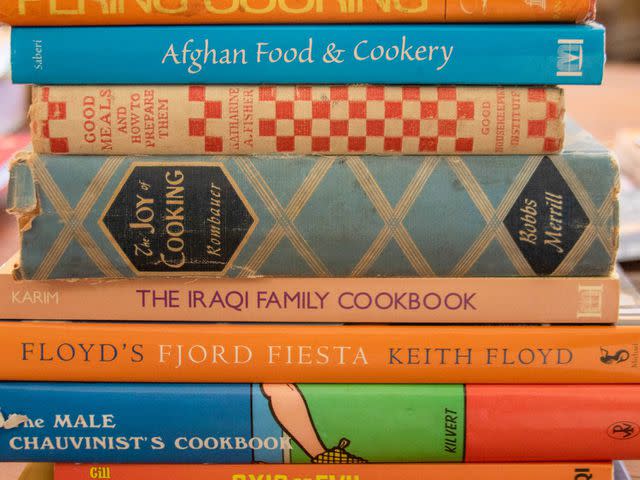
Serious Eats / Stephanie Cameron
Have you had your cookbook collection professionally appraised?
SJ: No. I have a pretty good idea of the value, based on some research and the current prices for more recent books. Many of the books that I wish I had kept from my first collection were of some value. I had a first edition of the cookbook that Salvador Dalí wrote, Les Dîners de Gala, which I sold for $200 back in 1999. I wish I had it now.
What’s the oldest cookbook in your collection? What’s the most recent? Which one has the most outlandish recipes?
SJ: My current collection doesn’t feature any really antique cookbooks. I think the earliest one I have now is European and American Cuisine, published in 1897 by Gesine Lemcke. I do have a number of smaller booklets, probably published slightly earlier, but the publication dates are unknown.
The most recent book is Deep Run Roots: Stories and Recipes From My Corner of the South, by Vivian Howard, published in 2016. I would say the bulk of my collection is dated between 1930 and 1970.
As for outlandish recipes, wow, pick any cookbook! How about "Banana and Popcorn Salad," "Fruit and Flower Frozen Cheese Salad," "Chipped Beef and Pineapple," "Roast Possum with Sweet Potatoes," "Barbecued Bologna for Men a la Crisco," "Bologna Cake," "Wedgies a.k.a. Bologna Pie," "Baked Beans au Glow-Glow," "Rosin Baked Potatoes," "Cheetos and Milk," "Olives with White Chocolate," or "Coke with Red Wine"? Perhaps "Rack of Spam" or "Peanut Butter and Jelly Soup," or "Butt’s Gator Tail"?
Some of the "outlandish" recipes, to us, are not so outlandish in other parts of the world. For example, from The Congo Cookbook, "Chicken Moamba" is most definitely not a time-saver:
1. Three days before preparing the recipe, send your houseman up a palm tree to bring down the nuts.
2. Extract the palm oil from the nuts in a sturdy, stone mortar.
3. The day before, slaughter a chicken from your chicken coop and pluck it.
4. Marinate the chicken in the palm oil.
5. The day you prepare the recipe, cut some manioc leaves from manioc plants in your vegetable garden and chop them coarsely.
6. Sauté the chicken in the palm oil until tender.
7. Steam the manioc leaves in a colander.
8. Prepare white rice in your favorite way.
9. Take Alka Seltzer after eating the meal.
10. Do not have Chicken Moamba two days in a row.
Also from The Congo Cookbook is "Rats in the Mood" (yes, real rats). Yet, one has to consider the source; that is, the location, the environment, geography, wildlife, accessibility of clean water and a reliable food source, before we can describe a recipe as "outlandish."
There are some books I’d really like to add to my collection, but I've only read about their existence: Cooking with Poo, Let’s Play Hide the Sausage, and Cooking for Raccoons. Then there is the elusive Eating People Is Wrong, and How to Raise Your I.Q. by Eating Gifted Children. I’d love a copy of The Dead Celebrity Cookbook, Cooking to Kill, You’ve Had Worse Things in Your Mouth, or The Jewish-Japanese Sex & Cook Book and How to Raise Wolves.
Any resources for cookbook acquisition you’d like to highlight for other cookbook collectors? Forums, communities, et cetera?
SJ: The best sources by far are thrift shops, used-book stores, and estate sales. Antique stores often have older books, but they are pricey. I have also found that as word travels around that I am a collector, people will email or call to sell or donate books to my collection. Some have inherited a few and simply don’t want them, but want them to go where they are appreciated. For remainder books (recent, but sometimes out of print) at great prices, I recommend Edward Hamilton Books, in Connecticut.
If you have any social media pages, you can indicate that you are looking for cookbooks to add to your collection. A wonderful site for cookbook lovers is Eat Your Books. A $30 annual fee allows you to add cookbooks that they have indexed on their virtual shelves (they have more than 160,000 books, I believe) to your own cookbooks. Once you have matched yours to theirs, you can search your own collection by any combination of search criteria: ingredient, ethnic origin, dish type, et cetera. I share approximately 5,200 cookbooks with them, which allows me to easily find a recipe.
This interview has been edited and condensed for clarity.
Editor's Note
This interview was originally published as part of the column Obsessed, the series in which we talk to uniquely driven amateurs and professionals from all across the food world.
May 2018
Read the original article on Serious Eats.

